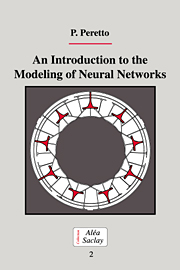Book contents
- Frontmatter
- Contents
- Preface
- Acknowledgments
- 1 Introduction
- 2 The biology of neural networks: a few features for the sake of non-biologists
- 3 The dynamics of neural networks: a stochastic approach
- 4 Hebbian models of associative memory
- 5 Temporal sequences of patterns
- 6 The problem of learning in neural networks
- 7 Learning dynamics in ‘visible’ neural networks
- 8 Solving the problem of credit assignment
- 9 Self-organization
- 10 Neurocomputation
- 11 Neurocomputers
- 12 A critical view of the modeling of neural networks
- References
- Index
10 - Neurocomputation
Published online by Cambridge University Press: 30 November 2009
- Frontmatter
- Contents
- Preface
- Acknowledgments
- 1 Introduction
- 2 The biology of neural networks: a few features for the sake of non-biologists
- 3 The dynamics of neural networks: a stochastic approach
- 4 Hebbian models of associative memory
- 5 Temporal sequences of patterns
- 6 The problem of learning in neural networks
- 7 Learning dynamics in ‘visible’ neural networks
- 8 Solving the problem of credit assignment
- 9 Self-organization
- 10 Neurocomputation
- 11 Neurocomputers
- 12 A critical view of the modeling of neural networks
- References
- Index
Summary
Neural networks are at the crossroad of several disciplines and the putative range of their applications is immense. The exploration of the possibilities is just beginning. Some domains, such as pattern recognition, which seemed particularly suited to these systems, still resist analysis. On the other hand, neural networks have proved to be a convenient tool to tackle combinatorial optimization problems, a domain to which at first sight they had no application. This indicates how difficult is the task of foreseeing the main lines of developments yet to come. All that can be done now is to give a series of examples, which we will strive to arrange in a logical order, although the link between the various topics is sometimes tenuous. Most of the applications we shall present were put forward before the fall of 1988.
Domains of applications of neural networks
Neural networks can be used in different contexts:
For the modeling of simple biological structures whose functions are known. The study of central pattern generators is an example.
For the modeling of higher functions of central nervous systems, in particular of those properties such as memory, attention, etc., which experimental psychology strives to quantify. Two strategies may be considered. The first consists in explaining the function of a given neural formation (as far as the function is well understood) by taking all available data on its actual structure into account. This strategy has been put forward by Marr in his theory of the cerebellum. The other strategy consists in looking for the minimal constraints that a neuronal architecture has to obey in order to account for some psychophysical property. The structure is now a consequence of the theory. If the search has been successful, it is tempting to identify the theoretical construction with biological structures which display the same organization.
[…]
- Type
- Chapter
- Information
- An Introduction to the Modeling of Neural Networks , pp. 325 - 378Publisher: Cambridge University PressPrint publication year: 1992

